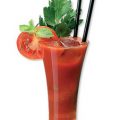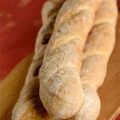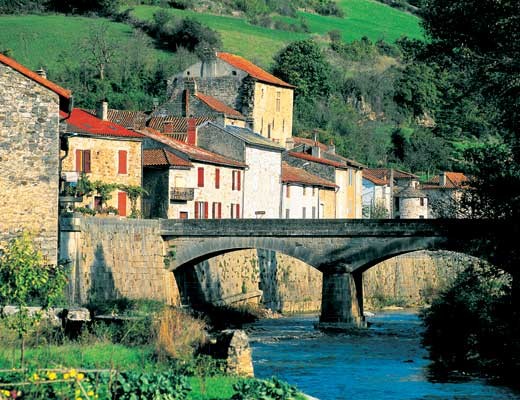 Roquefort cheese Charles de Gaulle once joked: «Как можно управлять страной, в которой столько же сортов сыра, сколько дней в году!» Однако, назвав немалую цифру, явно поскромничал. Их не менее 500, хотя точного количества, как, впрочем, и всех названий, не знает ни один француз. Чтобы навести в этом вопросе порядок, великие кулинары даже попытались составить «Карту французских сыров», но места на географической карте хватило только шестидесяти самым известным сортам. Очень символично, что центральное место на ней (как по местонахождению сыроварен, так и по значимости) занимает рокфор, или Мсье Фромаж (фр. fromage — «сыр»), как его уважительно называют французы. Его вкусовые качества оценены по достоинству во всем мире. Наверное, поэтому, лишенные этого деликатеса австралийцы, столь рьяно добивались официального разрешения правительства на право продажи сыра на Зеленом континенте, куда долгие годы ввоз непастеризованного продукта был запрещен. Но настойчивость гурманов сломила упорство чиновников. И в октябре прошлого года министр по делам здравоохранения все-таки объявил о снятии эмбарго. Особые приметы«Давно коронованный у себя на родине рокфор — одна из самых раскрученных сырных марок, фактически ставшая родоначальником семейства «голубых сыров», — говорит шеф-повар ресторана Portofino Евгений Запольский.— И главное, это сыр абсолютно узнаваемый, хотя к его специфическому, пикантному вкусу даже искушенные специалисты относятся по-разному». Для сегодняшнего российского гурмана знаменитый сыр рокфор не диковинка: без этого деликатеса не обходится меню ни одного дорогого французского ресторана или гастрономического бутика, да и на прилавках отечественных магазинов он давно уже не редкость. Однако оценить его качество и происхождение, не будучи профессионаломаффинером (так во Франции называют сыроваров), практически невозможно. «Доступные сегодняшнему покупателю немецкий сыр из коровьего молока бергадер и французский сент-агюр почти неотличимы от знаменитого собрата. И для рядового потребителя главным отличием между этими : так, немецкий аналог рокфора на 30—40 % дешевле своего прославленного французского родственника», — рассказывает корпоративный шеф-повар компании «Восток-Запад Сервис» Константин Жбаков. Присутствие на рынке разных видов рокфора никак не увязывается с общеизвестным фактом глубокой засекреченности уходящего корнями в глубь веков Великого сыроварного ноу-хау и вселяет вполне понятные сомнения по поводу качества незаконно претендующих на королевский трон сыров-«самозванцев». Тем же, кто хочет полакомиться настоящим рокфором, помогут сориентироваться его упаковка и цена. Доставляемый в Россию авиа- или автотранспортом драгоценный товар — продукт компании «Сосьете» (Societe), занимающейся его производством без малого полтора века, о чем на упаковке имеется соответствующая надпись «Depuis 1863». Кстати, за выдающиеся заслуги на ниве элитного сыроварения еще в далеком 1867 году фирма «Сосьете» была удостоена ордена Почетного легиона. Сыр поступает в продажу в пластиковых вакуумных упаковках весом 100 и 150 г или в виде облаченных в двойную пергаментную бумагу и пищевую пленку сырных «полуголов» (полудисков) весом 1 и 1,25 кг для продажи на развес. Уникальная упаковка одновременно не промокает и дышит, не давая сыру задохнуться.
Roquefort cheese Charles de Gaulle once joked: «Как можно управлять страной, в которой столько же сортов сыра, сколько дней в году!» Однако, назвав немалую цифру, явно поскромничал. Их не менее 500, хотя точного количества, как, впрочем, и всех названий, не знает ни один француз. Чтобы навести в этом вопросе порядок, великие кулинары даже попытались составить «Карту французских сыров», но места на географической карте хватило только шестидесяти самым известным сортам. Очень символично, что центральное место на ней (как по местонахождению сыроварен, так и по значимости) занимает рокфор, или Мсье Фромаж (фр. fromage — «сыр»), как его уважительно называют французы. Его вкусовые качества оценены по достоинству во всем мире. Наверное, поэтому, лишенные этого деликатеса австралийцы, столь рьяно добивались официального разрешения правительства на право продажи сыра на Зеленом континенте, куда долгие годы ввоз непастеризованного продукта был запрещен. Но настойчивость гурманов сломила упорство чиновников. И в октябре прошлого года министр по делам здравоохранения все-таки объявил о снятии эмбарго. Особые приметы«Давно коронованный у себя на родине рокфор — одна из самых раскрученных сырных марок, фактически ставшая родоначальником семейства «голубых сыров», — говорит шеф-повар ресторана Portofino Евгений Запольский.— И главное, это сыр абсолютно узнаваемый, хотя к его специфическому, пикантному вкусу даже искушенные специалисты относятся по-разному». Для сегодняшнего российского гурмана знаменитый сыр рокфор не диковинка: без этого деликатеса не обходится меню ни одного дорогого французского ресторана или гастрономического бутика, да и на прилавках отечественных магазинов он давно уже не редкость. Однако оценить его качество и происхождение, не будучи профессионаломаффинером (так во Франции называют сыроваров), практически невозможно. «Доступные сегодняшнему покупателю немецкий сыр из коровьего молока бергадер и французский сент-агюр почти неотличимы от знаменитого собрата. И для рядового потребителя главным отличием между этими : так, немецкий аналог рокфора на 30—40 % дешевле своего прославленного французского родственника», — рассказывает корпоративный шеф-повар компании «Восток-Запад Сервис» Константин Жбаков. Присутствие на рынке разных видов рокфора никак не увязывается с общеизвестным фактом глубокой засекреченности уходящего корнями в глубь веков Великого сыроварного ноу-хау и вселяет вполне понятные сомнения по поводу качества незаконно претендующих на королевский трон сыров-«самозванцев». Тем же, кто хочет полакомиться настоящим рокфором, помогут сориентироваться его упаковка и цена. Доставляемый в Россию авиа- или автотранспортом драгоценный товар — продукт компании «Сосьете» (Societe), занимающейся его производством без малого полтора века, о чем на упаковке имеется соответствующая надпись «Depuis 1863». Кстати, за выдающиеся заслуги на ниве элитного сыроварения еще в далеком 1867 году фирма «Сосьете» была удостоена ордена Почетного легиона. Сыр поступает в продажу в пластиковых вакуумных упаковках весом 100 и 150 г или в виде облаченных в двойную пергаментную бумагу и пищевую пленку сырных «полуголов» (полудисков) весом 1 и 1,25 кг для продажи на развес. Уникальная упаковка одновременно не промокает и дышит, не давая сыру задохнуться. 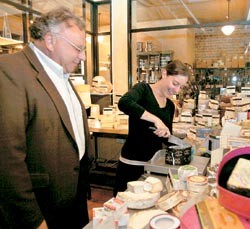 In the center of the old-fashionedThe manuscript of the original packaging also shows the place and the way of production of the roquefort - "Affine'е en Caves Naturelles", that is, in the natural stone grottoes of the communal Roquefort-sur-Suzlon. The authenticity of the fact that cheese is made from fat sheep's milk (more than 50%) is confirmed by a red trademark in the form of a sheep's oval-shaped oval. The next landmark is a truly royal price. Among the impressive number of "Seventh Continent" shops in the assortment of Roquefort cheeses is the most expensive: the cost of a hundred-gram segment standing proudly on the shelf is 189 rubles 90 kopecks. The order of prices in the gastronomic boutique of Nediard is similar. For comparison: the nearest relatives of roquefort Dorbl and Camembert are offered at a price of almost 100 rubles less for the same amount. Purchased for weight, roquefort will cost a bit cheaper: the classical variety (52% fat, a larger half-disk in a package with green letters) is sold here at 1 490 rubles per 1 kg. However, the high store prices for roquefort fade in comparison with the sky-high restaurants: the cost of the "Big cheese plate" in the dessert menu of the French restaurant Carre Blanc, which, together with the other sixteen kinds of cheese includes, of course, Roquefort, is approaching the store price of 1 kg of elite cheese. Patriarch among the cheeses Each famous cheese necessarily has its own legend. She also has a roquefort. Although much of it, starting with the widespread version of the origin, seems reliable only to the French themselves. For most people it's nothing more than a fairy tale. So, a certain shepherd boy, having seen a young beauty, forgot about his breakfast - a piece of young sheep's cheese and a piece of rye bread and rushed to catch up with her. After a while, the young man returned to the abandoned food and - oh, a miracle! - found that it turned into a piece of the most perfect of cheeses. The unreliability of this plot is obvious: innocent people, thinking exclusively about the romantic side of life of the shepherdess, inhabited only the public consciousness of the century of sentimentalism, in reality they never existed. You can also question the very date of the cheese. The French say that the age of the roquefort is 900 years old, giving as historical evidence the obrokal lists, in fact - the list of products brought by the peasants to his suzerain as a tribute. Such information does not allow us to accurately talk about the scale of the production of the roquefort and its original taste, but it allows us to judge that this cheese did not have any special gastronomic significance - the peasants did not share delicacies with the feudal lords, but with what they ate themselves. However, the figure 900 somehow magically causes ambitious Frenchmen to convince everyone that roquefort is the oldest of the "thoroughbred" cheeses in the world. Although this is not so. Their desire to be on this issue is the first to be explained, but it is unclear why they forget about the French same Marolie cheese, which, judging by the surviving monastic records, is a hundred years older than the roquefort. Perhaps the reason that the French give the last palm of primacy is hidden in its exceptional taste.
In the center of the old-fashionedThe manuscript of the original packaging also shows the place and the way of production of the roquefort - "Affine'е en Caves Naturelles", that is, in the natural stone grottoes of the communal Roquefort-sur-Suzlon. The authenticity of the fact that cheese is made from fat sheep's milk (more than 50%) is confirmed by a red trademark in the form of a sheep's oval-shaped oval. The next landmark is a truly royal price. Among the impressive number of "Seventh Continent" shops in the assortment of Roquefort cheeses is the most expensive: the cost of a hundred-gram segment standing proudly on the shelf is 189 rubles 90 kopecks. The order of prices in the gastronomic boutique of Nediard is similar. For comparison: the nearest relatives of roquefort Dorbl and Camembert are offered at a price of almost 100 rubles less for the same amount. Purchased for weight, roquefort will cost a bit cheaper: the classical variety (52% fat, a larger half-disk in a package with green letters) is sold here at 1 490 rubles per 1 kg. However, the high store prices for roquefort fade in comparison with the sky-high restaurants: the cost of the "Big cheese plate" in the dessert menu of the French restaurant Carre Blanc, which, together with the other sixteen kinds of cheese includes, of course, Roquefort, is approaching the store price of 1 kg of elite cheese. Patriarch among the cheeses Each famous cheese necessarily has its own legend. She also has a roquefort. Although much of it, starting with the widespread version of the origin, seems reliable only to the French themselves. For most people it's nothing more than a fairy tale. So, a certain shepherd boy, having seen a young beauty, forgot about his breakfast - a piece of young sheep's cheese and a piece of rye bread and rushed to catch up with her. After a while, the young man returned to the abandoned food and - oh, a miracle! - found that it turned into a piece of the most perfect of cheeses. The unreliability of this plot is obvious: innocent people, thinking exclusively about the romantic side of life of the shepherdess, inhabited only the public consciousness of the century of sentimentalism, in reality they never existed. You can also question the very date of the cheese. The French say that the age of the roquefort is 900 years old, giving as historical evidence the obrokal lists, in fact - the list of products brought by the peasants to his suzerain as a tribute. Such information does not allow us to accurately talk about the scale of the production of the roquefort and its original taste, but it allows us to judge that this cheese did not have any special gastronomic significance - the peasants did not share delicacies with the feudal lords, but with what they ate themselves. However, the figure 900 somehow magically causes ambitious Frenchmen to convince everyone that roquefort is the oldest of the "thoroughbred" cheeses in the world. Although this is not so. Their desire to be on this issue is the first to be explained, but it is unclear why they forget about the French same Marolie cheese, which, judging by the surviving monastic records, is a hundred years older than the roquefort. Perhaps the reason that the French give the last palm of primacy is hidden in its exceptional taste.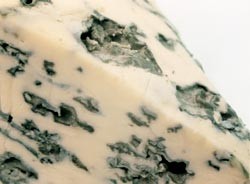 Spicy details "Freezing roquefort, likeheated, undesirable, "Konstantin Zhbakov believes. "Of course, due to its high fat content, this variety can withstand the effects of low temperatures, but hypothermia still spoils its consumer qualities." However, if the purchased piece of cheese can not be eaten immediately, then it is better to keep it in the refrigerator at a temperature of + 2-6 ° C in a jar with a glass lid or wrapped in foil or parchment paper. Only in this way can the valuable product be isolated from the effects of foreign smells and simultaneously from its harmful moisture and drying: moist oily cheese has the property of giving off liquid. Also, we should not forget that during the storage process the ripening process does not end, it continues to be enriched with a piquant taste. Fresh Roquefort inside is soft, combines a touch of freshness and freshness and is devoid of an unpleasant aftertaste. Most often it is served as a snack for wine in its pure form or with other sorts of cheese. To cut the roquefort is used invented in his homeland device, called la roquefortaise - "rokfortezka." It is a machine tool, the cutting element of which is a stretched wire. The minimal cutting surface allows not to break the structure of soft mold inside the cheese, which is easy to crumple with an ordinary, even well-ground knife. Cheese slices are usually eaten clockwise. Different sorts of cheese are laid out on a plate in a circle from the most neutral - creamy goat to the most acute - a roquefort: it is difficult to feel another taste after it. Often, a connoisseur is enough for one thin plate of a roquefort to enjoy its unusual taste in combination with wine. Therefore, although roquefort is ordered frequently, it is consumed in small quantities, just like a delicacy. With respect to the roquefort, the rule of classical cheese combinations applies. Sweets perfectly harmonize with it: honey, confiture, nuts and fresh fruits (mango, pears, grapes, strawberries, currants and many others except citrus fruits). A very unusual combination of salted with sweet is appreciated by many - however, the boundaries of combining the two polar tastes are determined by everyone. Winning is also a combination of roquefort with vegetables and herbs - the cheese is in good harmony with olive oil and pepper in a variety of salads. Like all products with a pronounced, concentrated taste, Roquefort is perfectly complemented by neutral food, is successfully shaded with bread, and not only white, but also rye. In expensive Italian restaurants tart taste of roquefort is used in the composition of pasta and pizza. Roquefort is used both in its natural form, and when making dishes - sauces, soups, fondue with cheeses of a more restrained taste. The sharp taste of classic cold and hot sauces based on roquefort is well combined with neutral vegetables, for example with cabbage or potatoes. With a sauce of roquefort and other "blue cheeses" are served chicken wings, duck breast, shrimp. However, a number of features of the capricious "king of cheeses" make it difficult to use in cooking. Roquefort poorly tolerates heat treatment, so when making, for example, sauces, it is added in the last turn. In addition, Roquefort and in the form of sauce has the property of insisting. For this reason, cooks often refuse to use it in cooking, trying to switch to dorbly as a less spicy and cheaper cheese. What beverages are consumed by cheese, which has such an original taste? Fans of precise instructions will be disappointed.
Spicy details "Freezing roquefort, likeheated, undesirable, "Konstantin Zhbakov believes. "Of course, due to its high fat content, this variety can withstand the effects of low temperatures, but hypothermia still spoils its consumer qualities." However, if the purchased piece of cheese can not be eaten immediately, then it is better to keep it in the refrigerator at a temperature of + 2-6 ° C in a jar with a glass lid or wrapped in foil or parchment paper. Only in this way can the valuable product be isolated from the effects of foreign smells and simultaneously from its harmful moisture and drying: moist oily cheese has the property of giving off liquid. Also, we should not forget that during the storage process the ripening process does not end, it continues to be enriched with a piquant taste. Fresh Roquefort inside is soft, combines a touch of freshness and freshness and is devoid of an unpleasant aftertaste. Most often it is served as a snack for wine in its pure form or with other sorts of cheese. To cut the roquefort is used invented in his homeland device, called la roquefortaise - "rokfortezka." It is a machine tool, the cutting element of which is a stretched wire. The minimal cutting surface allows not to break the structure of soft mold inside the cheese, which is easy to crumple with an ordinary, even well-ground knife. Cheese slices are usually eaten clockwise. Different sorts of cheese are laid out on a plate in a circle from the most neutral - creamy goat to the most acute - a roquefort: it is difficult to feel another taste after it. Often, a connoisseur is enough for one thin plate of a roquefort to enjoy its unusual taste in combination with wine. Therefore, although roquefort is ordered frequently, it is consumed in small quantities, just like a delicacy. With respect to the roquefort, the rule of classical cheese combinations applies. Sweets perfectly harmonize with it: honey, confiture, nuts and fresh fruits (mango, pears, grapes, strawberries, currants and many others except citrus fruits). A very unusual combination of salted with sweet is appreciated by many - however, the boundaries of combining the two polar tastes are determined by everyone. Winning is also a combination of roquefort with vegetables and herbs - the cheese is in good harmony with olive oil and pepper in a variety of salads. Like all products with a pronounced, concentrated taste, Roquefort is perfectly complemented by neutral food, is successfully shaded with bread, and not only white, but also rye. In expensive Italian restaurants tart taste of roquefort is used in the composition of pasta and pizza. Roquefort is used both in its natural form, and when making dishes - sauces, soups, fondue with cheeses of a more restrained taste. The sharp taste of classic cold and hot sauces based on roquefort is well combined with neutral vegetables, for example with cabbage or potatoes. With a sauce of roquefort and other "blue cheeses" are served chicken wings, duck breast, shrimp. However, a number of features of the capricious "king of cheeses" make it difficult to use in cooking. Roquefort poorly tolerates heat treatment, so when making, for example, sauces, it is added in the last turn. In addition, Roquefort and in the form of sauce has the property of insisting. For this reason, cooks often refuse to use it in cooking, trying to switch to dorbly as a less spicy and cheaper cheese. What beverages are consumed by cheese, which has such an original taste? Fans of precise instructions will be disappointed. 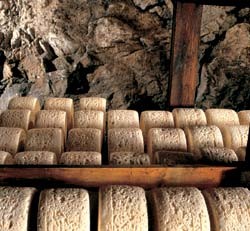 Experimenters, on the contrary, will inspire the spacefor creativity. Sweet wines like Cahors, sauternes and porto, liqueur-type muscatel, dry red and sweet white ... Recommendations are so contradictory that it seems that they will have to find the perfect taste themselves. The natives of France, who are familiar with the great cheese firsthand, are firmly convinced that the land that gave birth to it has taken care of the ideal addition to the rockfort, giving people mineral waters from local sources - in particular, the water "Kezak" and "Shod-zeg" from the hot (more than 80 ° C) source. But the notorious Casanova advised the aspirants "to give maturity to the newly-formed feeling" to treat the ladies with a rockfellow and a famous Burgundy wine with a Chamberlain. The choice can be limited only by culinary imagination. Property of the inhabitants of Roquefort Many lovers and connoisseurs believe that Roquefort generally stands in relation to all cheeses somewhat apart. It's all about the specifics of production. A real cheese, called rockforth, according to the decree of Charles VI of 1411, has the right to do only residents of the town of Roquefort. They prepare it from sheep's milk, and farmers specifically restrict animals to drink, so that their milk acquires a high fat content.
Experimenters, on the contrary, will inspire the spacefor creativity. Sweet wines like Cahors, sauternes and porto, liqueur-type muscatel, dry red and sweet white ... Recommendations are so contradictory that it seems that they will have to find the perfect taste themselves. The natives of France, who are familiar with the great cheese firsthand, are firmly convinced that the land that gave birth to it has taken care of the ideal addition to the rockfort, giving people mineral waters from local sources - in particular, the water "Kezak" and "Shod-zeg" from the hot (more than 80 ° C) source. But the notorious Casanova advised the aspirants "to give maturity to the newly-formed feeling" to treat the ladies with a rockfellow and a famous Burgundy wine with a Chamberlain. The choice can be limited only by culinary imagination. Property of the inhabitants of Roquefort Many lovers and connoisseurs believe that Roquefort generally stands in relation to all cheeses somewhat apart. It's all about the specifics of production. A real cheese, called rockforth, according to the decree of Charles VI of 1411, has the right to do only residents of the town of Roquefort. They prepare it from sheep's milk, and farmers specifically restrict animals to drink, so that their milk acquires a high fat content. 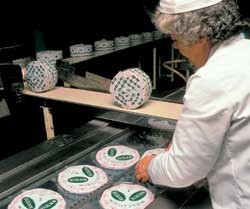 Fresh sheep milk is heated to 26 ° C and brought inrennet extract. Sychug is one of the sections of the sheep stomach, which is distinguished by an increased concentration of enzymes. For the rockhorse, the abomasum of five to six-month-old lambs is used (incidentally, this serves as the basis for the periodic claims made to the producers of the rockforge by various activists of movements for the ethical treatment of animals). After one and a half hours, the acidified milk is heated until divided into serum and a cheese bunch, the latter is separated and cut into pieces the size of a walnut. These pieces are laid out according to the forms. The size of the forms is strictly regulated, as the size and configuration of the heads of the roquefort are important signs of its authenticity. So, these shapes have a height of 8.7 cm and a diameter of 21 cm. So far, it would seem, nothing unusual. But here's the first detail that makes roquefort a rockopher. Before you put the cheese clot in a mold, mold moldy bread crumbs on its bottom. And exactly the same crumbs are poured onto the clot before closing the mold. So the mold falls into mold. From this moment it is called delicacy. The penicillium rocforti mold was seen by anyone who was holding a moldy piece of bread in his hands. Nobility and blue-green color, it acquires, being sown in a cheese curd. There are no special strains of this mold, deduced in ancient times by the medieval alchemists. The miracle of a rock-rounder is not in some unseen ingredients, but in their unprecedented connection. The most important and yet truly inimitable detail of cheese production is its aging in the caves of Mount Kombalu, which is located in the central part of France.
Fresh sheep milk is heated to 26 ° C and brought inrennet extract. Sychug is one of the sections of the sheep stomach, which is distinguished by an increased concentration of enzymes. For the rockhorse, the abomasum of five to six-month-old lambs is used (incidentally, this serves as the basis for the periodic claims made to the producers of the rockforge by various activists of movements for the ethical treatment of animals). After one and a half hours, the acidified milk is heated until divided into serum and a cheese bunch, the latter is separated and cut into pieces the size of a walnut. These pieces are laid out according to the forms. The size of the forms is strictly regulated, as the size and configuration of the heads of the roquefort are important signs of its authenticity. So, these shapes have a height of 8.7 cm and a diameter of 21 cm. So far, it would seem, nothing unusual. But here's the first detail that makes roquefort a rockopher. Before you put the cheese clot in a mold, mold moldy bread crumbs on its bottom. And exactly the same crumbs are poured onto the clot before closing the mold. So the mold falls into mold. From this moment it is called delicacy. The penicillium rocforti mold was seen by anyone who was holding a moldy piece of bread in his hands. Nobility and blue-green color, it acquires, being sown in a cheese curd. There are no special strains of this mold, deduced in ancient times by the medieval alchemists. The miracle of a rock-rounder is not in some unseen ingredients, but in their unprecedented connection. The most important and yet truly inimitable detail of cheese production is its aging in the caves of Mount Kombalu, which is located in the central part of France. 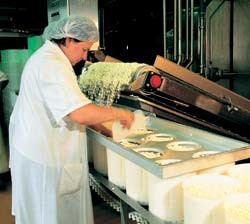 Now Roquefort is of two kinds - producedindustrially, at the dairy, and farm, that is, made by handicraft. But in that, and in other cases, it takes place in a limestone cave. Numerous cracks in the rocks maintain a constant temperature in the range of 4 to 7 ° C, fresh air and constant humidity, which are ideal conditions for the growth of penicillin fungus. Today, in the caves, which were expanded and have a volume of only 90,000 cubic meters, an annual 16,000 tons of rope are ripening. So, ready-to-mature cheese in the form is rubbed with dry salt, and then pierced with long needles, producing in each head up to 60 punctures. This is done to prevent excessive mold formation on the outside of the cheese and, conversely, to provide good conditions for its germination inside. Exposure of the product is carried out within 3 months, and all this time for the state of its surface vigilantly watched, if necessary cleaning it with a knife. The minimum allowable aging time is a month, the maximum is 5. During this time, the taste and smell of the roquefort undergo significant changes. At an early stage, Roquefort, like most cheeses made of sheep's milk, has a characteristic sharp taste. But after 60 days, the taste completely disappears, but the development of cheese does not stop there. By the fifth month of aging, it acquires a sharp, very sharp taste and smell, which in the sixth month is modified already into an almost indecent, moldy bouquet, which makes it possible to classify a six-month-old roquefort as overexposed. And here everything depends on the conscience of the supplier. Yes exactly! It is clear that cheese is not mature or overripe for sale cheaper than cheese of ideal maturity. Consequently, the suppliers appear some temptations. And if the cheese is not ripe yet has some chances to reach the condition, well, at least in the storehouse of the grocery store, then the overripe can simply repulse any interest to it. Those who want to enjoy the ideal rockfore, it is best to buy cheese, kept in the period from May to December.
Now Roquefort is of two kinds - producedindustrially, at the dairy, and farm, that is, made by handicraft. But in that, and in other cases, it takes place in a limestone cave. Numerous cracks in the rocks maintain a constant temperature in the range of 4 to 7 ° C, fresh air and constant humidity, which are ideal conditions for the growth of penicillin fungus. Today, in the caves, which were expanded and have a volume of only 90,000 cubic meters, an annual 16,000 tons of rope are ripening. So, ready-to-mature cheese in the form is rubbed with dry salt, and then pierced with long needles, producing in each head up to 60 punctures. This is done to prevent excessive mold formation on the outside of the cheese and, conversely, to provide good conditions for its germination inside. Exposure of the product is carried out within 3 months, and all this time for the state of its surface vigilantly watched, if necessary cleaning it with a knife. The minimum allowable aging time is a month, the maximum is 5. During this time, the taste and smell of the roquefort undergo significant changes. At an early stage, Roquefort, like most cheeses made of sheep's milk, has a characteristic sharp taste. But after 60 days, the taste completely disappears, but the development of cheese does not stop there. By the fifth month of aging, it acquires a sharp, very sharp taste and smell, which in the sixth month is modified already into an almost indecent, moldy bouquet, which makes it possible to classify a six-month-old roquefort as overexposed. And here everything depends on the conscience of the supplier. Yes exactly! It is clear that cheese is not mature or overripe for sale cheaper than cheese of ideal maturity. Consequently, the suppliers appear some temptations. And if the cheese is not ripe yet has some chances to reach the condition, well, at least in the storehouse of the grocery store, then the overripe can simply repulse any interest to it. Those who want to enjoy the ideal rockfore, it is best to buy cheese, kept in the period from May to December.  What is he like, this roquefort? Above it is covered with a shiny crust of white, always slightly moist. Its flesh is slightly oily, the blue mold forms small cavities. Cheese made by hand differs in that the mold inside is distributed unevenly. The smell of a roquefort is very complex and difficult to describe. We can only say that it should contain two basic tones - a powerful, pronounced smell of sheep's milk and a light, non-intrusive smell of mold. The remaining semitones depend only on the development of your sense of smell and imagination. Most talk about the smell of hazelnuts, poetic nature it resembles an autumn leaf fall, and the originals - a working copier. The taste of a roquefort is also ambiguous. In different places of the cheese head it is different. The most saturated - in the center, since it is there that is most of all mold. The most restrained feel at the crust. This distinction gave rise to the peculiar etiquette of the cutting of a roquefort. Each piece must necessarily be crusted and contain both the middle and outer parts of the head. To start eating this slice is better from a more fresh edge to a sharper one.
What is he like, this roquefort? Above it is covered with a shiny crust of white, always slightly moist. Its flesh is slightly oily, the blue mold forms small cavities. Cheese made by hand differs in that the mold inside is distributed unevenly. The smell of a roquefort is very complex and difficult to describe. We can only say that it should contain two basic tones - a powerful, pronounced smell of sheep's milk and a light, non-intrusive smell of mold. The remaining semitones depend only on the development of your sense of smell and imagination. Most talk about the smell of hazelnuts, poetic nature it resembles an autumn leaf fall, and the originals - a working copier. The taste of a roquefort is also ambiguous. In different places of the cheese head it is different. The most saturated - in the center, since it is there that is most of all mold. The most restrained feel at the crust. This distinction gave rise to the peculiar etiquette of the cutting of a roquefort. Each piece must necessarily be crusted and contain both the middle and outer parts of the head. To start eating this slice is better from a more fresh edge to a sharper one.

Making Money with Desserts: Success Stories
Yevhen Polishchuk (Fedutinov) instagram: @ evgeniyafedutinovavk.com / janeshomebaking– It all started with baking for relatives and friends. Gradually, she began uploading photos of her baking to Instagram, and orders began to come in. I made my first cake to order on October 13, 2014, and a little earlier I started making macarons and cupcakes. We can say that the business "found me myself", I am very [...]

Soups are cold recipes with photos
Cold cucumber soup with yogurt and lemonSorbet from La Taverna restaurant chef Alexander Zhurkina Photo: Getty Images Ingredients: Yoghurt without additives - 125 gCucumber - 150 gSorbet lemon / lime - 50 gCool shrimp - 24 gFresh ginger - 1 gLime lime - 5 gFresh orange juice - 5 gPetroshka - 1 g pink - 1 gCress salad - […]

barbeque kebab
Pork tenderloin glaze Photos: Dmitry Bayrak / dbstudio Cooking time: 20 minutes + time for pickling. Calorie content: 454 kcal per 1 serving. For 4 servings: 4 pork tenderloin (about 300 g each), 1 onion, 2 cloves of garlic, 1 tsp. lemon peel, 1 tsp. lemon juice, a pinch of ground cumin, coriander and turmeric, 1 tbsp. l vegetable [...]

Pierre Duacan: dietary recipes: Ducane diet
Beetroot Photo: Season'S, Luxury Hotels Representation You will need: · Boiled beets - 60 g · Fresh cucumbers - 20 g · Red radish - 20 g · Green onions - 10 g · Egg - 1 pcs · Mineral drinking water - 200 g · Salt - 1 g Ready: · Boil egg and beetroot. · Grind cucumbers, radishes and a part of beets. Putting everything [...]
